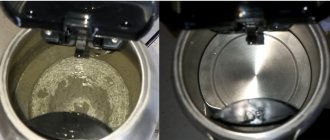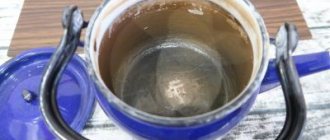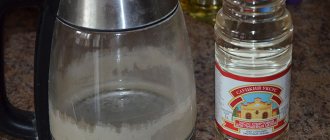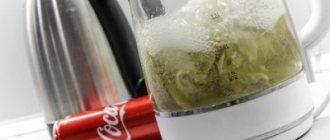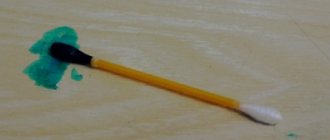An electric kettle is a great helper in the kitchen. It can be used to boil water in a few minutes.
In order for the device to function properly, it must be properly cared for. First of all, this concerns the removal of limescale, which regularly forms on its walls.
Read the article about how to quickly and safely remove scale from an electric kettle at home.
Why does it work
Arina Piskareva
Laboratory employee, Department of Bioengineering, Moscow State University
Scale is mainly composed of calcium and magnesium carbonate. When interacting with citric, acetic, orthophosphoric or other acid, sparingly soluble carbonates of alkaline earth metals are converted into readily soluble salts. For example, acetates. Therefore, acidic substances are effective in the fight against scale, and to enhance the reaction they need to be heated.
Soda, when interacting with water, produces carbonic acid molecules, which, in turn, react with insoluble calcium and magnesium carbonates, turning them into soluble bicarbonates. And they are easily washed off with water and removed with a sponge.
What to use?
Both the internal and external surfaces of the heating device are subject to treatment. Inside, as a rule, only limescale accumulates, but on the outside the body is covered with dust, splashes and drops of grease , which also need to be removed.
How to wash the inside?
Dealing with scale inside the kettle is allowed only with means that are not hazardous to health. We are talking about components that are edible or used for cooking.
These are soda and citric acid, carbonated drinks and vinegar, brines and fruit infusions. Such folk remedies will definitely not harm your health - they are time-tested and safe.
But it is prohibited to wash the inside of the kettle with aggressive chemicals - you can easily get poisoned.
Mine outside
The chemical requirements for cleaning the exterior of the housing are not too stringent.
An excellent way to clean the outside of a stainless steel device is with regular toothpaste.
A small amount is squeezed onto a toothbrush and the contaminated areas are scrubbed locally. If you need to clean the entire body, the paste can be applied to the hard side of a dishwashing sponge and walked over the entire area.
Baking soda can easily replace toothpaste . Dip a cloth into the powder and wipe the kettle in a circular motion. This method is good for both metal and plastic units.
Activated carbon is another affordable and effective remedy. 10-15 tablets should be crushed into powder and applied to pre-moistened outer walls. Leave for about an hour and rinse with clean water.
How to descale with citric acid
- Suitable for any kettles, coffee machines, irons, washing machines.
- Proportions : teapots, coffee machines and irons - 10 g for every 100 ml of water; washing machines - 50 g per kilogram of load.
- Pros : environmentally friendly, safe, affordable, pleasant aroma.
- Cons : does not cope with old, thick scale.
How to descale a kettle
Fill the kettle about ¾ full with water, so that the liquid covers the deposits on the walls and heating elements, but does not splash out when boiling.
Pour citric acid into a kettle (100 g of powder for every liter of water) and boil.
Leave until completely cool. Drain the water, remove any remaining plaque with a sponge and wash thoroughly.
How to descale a coffee machine
For a coffee machine, it is necessary to prepare a solution of citric acid based on the volume of the water reservoir. For example, if the coffee machine is designed for 2 liters, you will need 200 g of citric acid.
Pour the hot solution into the tank and leave for 60 minutes.
After an hour, start the coffee program without the coffee itself. Drain the liquid through dispensers.
Then run the coffee machine with only water, without citric acid. As soon as you pour out the boiling water, you can use the device. If the coffee machine reservoir is removable, remove any remaining deposits under running water.
How to descale your iron
Prepare a solution for the iron: add 10 g of citric acid for every 100 ml of boiling water, stir and cool to room temperature. Remove the anti-lime rod, if present, and soak in the resulting solution for an hour.
If not, pour the solution into the water tank. Turn on the iron and, holding it vertically, release steam until all the liquid is used up. It is better to do this over a bathtub or basin: along with the steam, scale will fly out of the holes in the sole.
After the procedure, rinse the iron reservoir with running water and wipe the sole with ammonia or nail polish remover.
How to descale your washing machine
To remove plaque from the heating elements and drum of the washing machine, you will need 50 g of acid per kilogram of load.
Place ¾ citric acid (190g acid per 5kg load) into the powder tray and ¹⁄₄ (60g) directly into the drum. Run the wash at maximum temperature.
Can it be cleaned?
You can clean the kettle with citric acid. The layer that forms inside is salt deposits. They no longer dissolve in ordinary water. To destroy their hard shell, exposure to more aggressive substances is necessary.
Citric acid is the most accessible, safe and inexpensive remedy that helps to quickly cope with the problem. You can clean the kettle with lemon. It does not harm its walls, does not cause them corrosion or oxidation.
The preservative works exclusively on the surface, dissolving solid deposits. In the future, you can use such a device without danger to your health.
How to descale with table vinegar
- Suitable for glass and ceramic teapots, stainless steel kettles, irons and washing machines.
- Proportions : teapots - 100 ml for each liter of water; irons - 1 tablespoon per liter of water; washing machines - 10 ml per kilogram of load.
- Plus : a more aggressive acidic environment removes even a thick layer of scale.
- Cons : may harm rubber and plastic elements of devices, pungent odor.
How to descale a kettle
To clean the kettle, dilute vinegar in water and place on fire. After boiling, let it simmer for a few more minutes. Then drain the water, remove any remaining deposits with a sponge and cleaning agent, and boil clean water in a kettle.
How to descale your iron
Pour the warm vinegar solution into the water reservoir and, holding the iron horizontally, release the steam.
Boil a kettle of vinegar and release steam from the iron only in a well-ventilated area.
How to descale your washing machine
In the washing machine, pour vinegar (10 ml per kilogram of load) into the cuvette for conditioner or liquid powder. Run the wash without laundry at maximum temperature, and then rinse again to be sure to get rid of the specific aroma.
Vinegar can damage the rubber bands on the door, so be careful if you decide to pour the product directly into the drum. This can be done when there are no liquid reservoirs in the machine.
Features of cleaning electrical appliances made of different materials
Depending on the material from which the kettle is made, the rules for cleaning it will differ.
Basic moments:
It is not recommended to use Coca-Cola or Fanta for plastic cutlery. These drinks contain dye that can be absorbed into the walls when heated, which will not have the best effect on the appearance of the device.- Kettles made of aluminum, copper, brass and galvanized metal are afraid of contact with acids. Therefore, it is better to use gentle products to clean them.
- It is not recommended to rub glass teapots with a wire brush to avoid scratches.
- Metal devices are afraid of contact with sharp objects.
How to clean scale with soda
- Suitable for any teapots, coffee machines.
- Proportions : teapots and coffee machines - 1 tablespoon for every 500 ml of water.
- Pros : accessibility, simplicity.
- Cons : does not remove all types of plaque, does not cope with old deposits.
The mechanism for cleaning teapots and coffee makers with soda is simple: fill them with water, add soda and boil. In this case, it is recommended not to remove a regular kettle from the heat for another 20–30 minutes after boiling, and to turn on an electric kettle several times.
After the procedure, wash the inside of the kettle or coffee machine reservoir and boil clean water.
If the plaque is very strong, try a more alkaline soda ash instead of baking soda. Or add the same amount of salt to regular soda.
How often should I clean?
The kettle needs to be cleaned regularly. If you carry out the procedure at least once a month, scale will not form. The cleaning time depends on the quality of the tap water.
If it is soft, then scale forms slowly. In this case, treatment can be carried out once every 1.5-2 months. If the water is hard, limescale deposits quickly. Therefore, preventive cleaning of the device is carried out once every 3-4 weeks.
Citric acid does not harm the kettle even with frequent contact with its walls.
How to descale with soda water
- Suitable for any teapots, coffee machines, irons.
- Proportions : the vessels are filled approximately ¾.
- Plus : effective even with thick plaque.
- Disadvantage : a colored drink may stain the vessel. Therefore, to clean irons and white plastic electric kettles, it is better to use clear soda, including mineral water.
How to descale a kettle or coffee machine
Open the bottle and wait until most of the carbon dioxide has evaporated.
Pour the soda into the kettle or coffee maker reservoir, hold for 15–20 minutes, and then boil.
Thanks to phosphoric acid and carbon dioxide, sodas do an excellent job of removing salt deposits.
How to descale your iron
Pour the soda into the water reservoir, turn on the appliance, hold the iron vertically and release steam. If there is a lot of scale, do this several times.
How to clean scale with brine
- Suitable for any teapots.
- Proportions : the kettle must be filled ¾ full.
- Pros : simplicity, accessibility.
- Cons : does not cope with persistent plaque, specific smell.
The brine contains lactic and acetic acids. Fill the kettle with strained cucumber or tomato brine and boil for 20–30 minutes.
After this, drain the brine and scale and wash the kettle with a soft sponge and cleaning agent.
Helpful information
To ensure that the procedure for removing lime deposits is effective and safe for health, you need to follow simple rules:
- You should not drink water from the kettle immediately after the procedure. First you need to boil it with clean water and drain it. Only after this can the device be fully used.
- All household members should be warned that the kettle is filled with descaling liquid. This will avoid poisoning.
- Once the cleaning solution boils, do not immediately pour it into the sink. The longer it stays inside, the higher the cleaning efficiency.
You can learn about methods and methods for descaling here.
How to clean scale with soda, citric acid and vinegar
- Suitable for any teapots.
- Proportions : 1 tablespoon of soda, 1 tablespoon of citric acid and a glass of vinegar per liter of water.
- Plus : even breaks up rock salt deposits.
- Disadvantage : troublesome, strong smell, exposure to aggressive components on devices.
Fill the kettle with water, add soda and citric acid and boil. If the kettle is electric, do this 2-3 times. If regular, let the lemon soda solution bubble for 20-30 minutes.
Drain and refill the kettle with water. Boil it and pour in vinegar. Leave for 15–20 minutes.
If after this the scale does not come off on its own, it will become loose. You can easily remove it with a sponge and dishwashing detergent.
At the end, boil clean water in the kettle again and then drain it.
Preventing the formation of lime deposits
In order for scale to form slowly in the kettle, you need to adhere to the following recommendations:
- use only soft water for boiling; you can pass it through a filter or fill it with bottled liquid;
- do not leave water in the kettle overnight, discarding any remaining water after the last use;
- do not boil water twice;
- Rinse the appliance after each boil.
For the purpose of prevention, you can use a sponge, which is used to treat the inside of the kettle at least once every 2-3 days.
